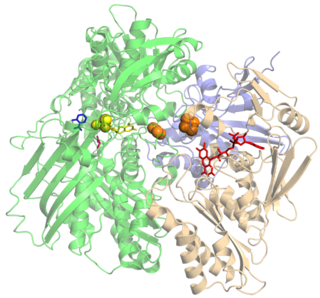| pyridoxal oxidase | |||||||||
|---|---|---|---|---|---|---|---|---|---|
| Identifiers | |||||||||
| EC no. | 1.2.3.8 | ||||||||
| CAS no. | 76415-81-1 | ||||||||
| Databases | |||||||||
| IntEnz | IntEnz view | ||||||||
| BRENDA | BRENDA entry | ||||||||
| ExPASy | NiceZyme view | ||||||||
| KEGG | KEGG entry | ||||||||
| MetaCyc | metabolic pathway | ||||||||
| PRIAM | profile | ||||||||
| PDB structures | RCSB PDB PDBe PDBsum | ||||||||
| Gene Ontology | AmiGO / QuickGO | ||||||||
| |||||||||
In enzymology, a pyridoxal oxidase (EC 1.2.3.8) is an enzyme that catalyzes the chemical reaction
- pyridoxal + H2O + O2 4-pyridoxate + (?)
The 3 substrates of this enzyme are pyridoxal, H2O, and O2, whereas its product is 4-pyridoxate.
This enzyme belongs to the family of oxidoreductases, specifically those acting on the aldehyde or oxo group of donor with oxygen as acceptor. The systematic name of this enzyme class is pyridoxal:oxygen 4-oxidoreductase. This enzyme participates in vitamin B6 metabolism. It employs one cofactor, molybdenum.



